A dainty hibiscus with delicate pink flowers graces our garden. It is a forest margin plant that grows wild mostly in the eastern parts of South Africa at low altitudes. It is nowhere near as well known as the popular exotic Chinese Hibiscus (Hibiscus rosa–sinensis) grown as an ornamental, but this indigenous South African plant is becoming increasingly adopted as a garden plant.
I was surprised to learn that there are nearly 60 species of hibiscus native to South Africa, ranging from low-growing herbs to shrubs and trees. But despite this fact, even here in South Africa the name Hibiscus is likely to conjure thoughts of tropical islands and travel brochures featuring cocktails served in coconuts and decorated with scarlet flowers. The Polynesian islands and Hawaii spring to mind …

Copied from Google Images, the red flowers (above left) are most likely Hibiscus rosa-sinensis, which although exotic are more likely to be associated with Hawaii than the indigenous yellow-flowered Hibiscus brackenridgei (pictured on the right above), which is the Hawaiian State flower
Far less showy and redolent of suntan oil than the Hibiscus rosa-sinensis is our rather more petite Forest Pink Hibiscus (Hibiscus pedunculatus). It is also known as the Pink Mallow. Hibiscus species belong to the large Malvaceae (mallow) family, comprising more than 2000 diverse species, which include cocoa, cotton, okra and baobab.

A flower of the Hibiscus pedunculatus showing its glowing rather than delicate pink
The flowers of the Forest Pink Hibiscus attract pollinators, and the insects in turn attract birds. Although each flower only lasts a day the plant is a generous flowerer and has a long flowering season. It does well in sun or dappled shade, flowering less in full shade. In the wild the colour of its flowers can vary from pale to a deeper pink through to lilac.

In addition to the showy flowers, the lobed leaves are also attractive

Flowers of the Forest Pink Hibiscus hosting tiny pollinators
Not only is the Forest Pink Hibiscus a generous flowerer it is also a generous self-seeder. I watch out for the seedlings that show up around the parent plants so as to establish some of them in pots until they are big enough to plant out elsewhere in the garden or to give away. The Forest Pink Hibiscus can also be propagated from cuttings.
Its bark is used in traditional medicine to treat urinary complaints and it is also used to make twine that can be used in hut building.
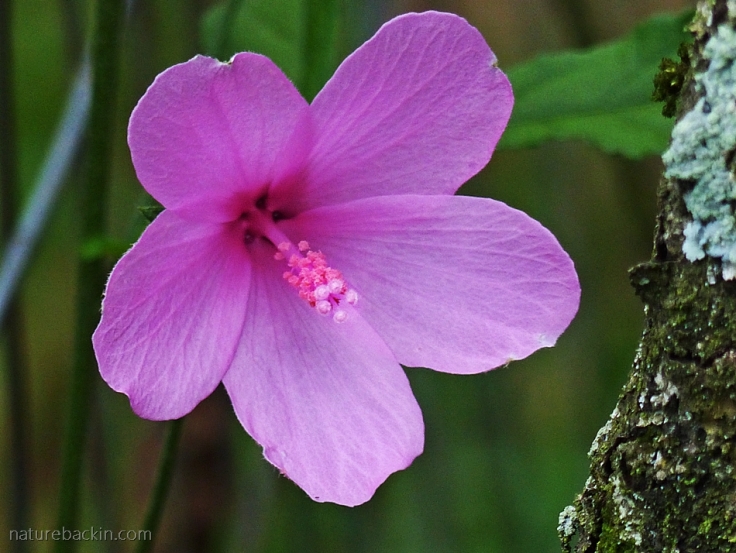
This close-up shows the stamens and pistils characteristic of hibiscus flowers
In addition to the flowers themselves, I also enjoy the attractive seeds. They last a long time on the plant before opening up and appearing to literally burst into seed.
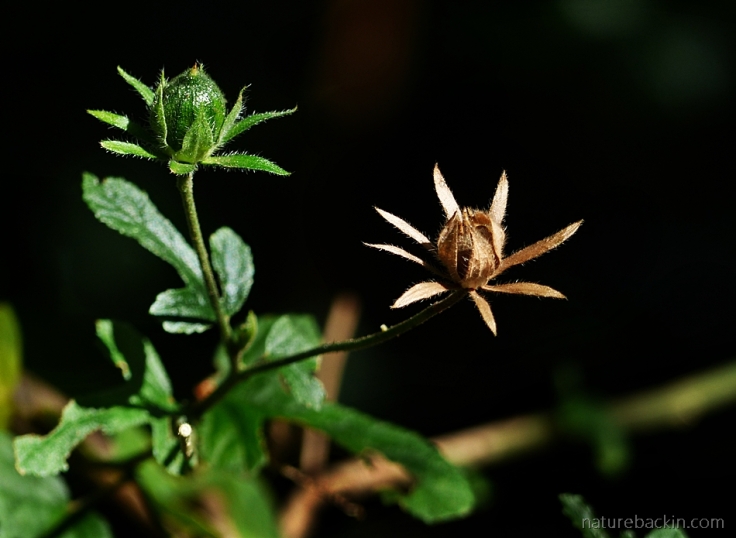
Two Forest Pink Hibiscus flowers of different ages going to seed
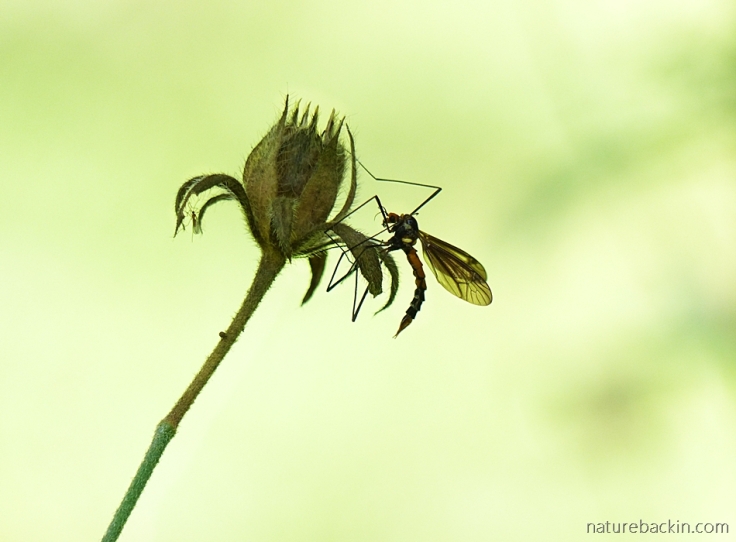
A slowly maturing seedhead providing a perch for a long-legged insect (which I have not yet identified)
The Forest Pink Hibiscus is the only Hibiscus we have growing in our garden. But further afield and in a variety of habitats there are numerous species of wild hibiscus, many bearing yellow flowers with dark centres, ranging in size from small low-growing herbs to shrubs to the Lagoon Hibiscus, which is classed as a tree.

One of the indigenous yellow-flowered hibiscus (possibly Hibiscus calyphyllus?) photographed at Ithala Game Reserve earlier this year

A close-up showing the dark centre of the flower
When looking up traditional uses for hibiscus in the book People’s Plants, the only hibiscus it mentions is the Lagoon Hibiscus (Hibiscus Tiliaceus), which is referred to in the book as the Wild Cotton Tree. As previously mentioned, commercial cotton plants also belong to the Malvaceae family, but in a different genus (Gossypium). However, the Lagoon Hibiscus is used for its bark rather than for anything resembling cotton. Its fibrous bark is similar in quality to jute and it is made into rope or twine. The wood is used for a variety of purposes including making living fences and it is used to make fish kraals that trap fish in Kosi Bay (a marine estuary in north-eastern KwaZulu-Natal).
The Lagoon Hibiscus is found in tropical areas across all continents (except Europe) and in the Pacific Islands. It is a coastal species and is known by many names including the Beach Hibiscus. It grows alongside lagoons and rivers and is salt tolerant. It can reach a height of up to 9 metres. Interestingly, the south coast of KwaZulu-Natal, perhaps as a marketing ploy, has been dubbed the Hibiscus Coast.
Unfortunately, I have very few photographs of the Lagoon Hibiscus in my photo archive, but I did find a few. Flowers start off yellow in colour, but I only found a photo of a flower deepening to apricot as it matures before turning a rusty red just before it drops off the tree to the ground. As in the Forest Pink Hibiscus, each flower lasts only a day.
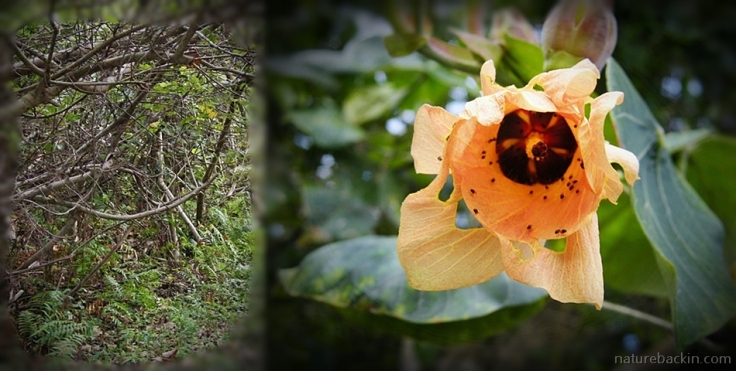
In the photos above, a glimpse of a thicket of multi-stemmed Lagoon Hibiscus growing on the inland shores of Kosi Bay, and a flower, well patronised by insects, turning apricot in colour as it matures
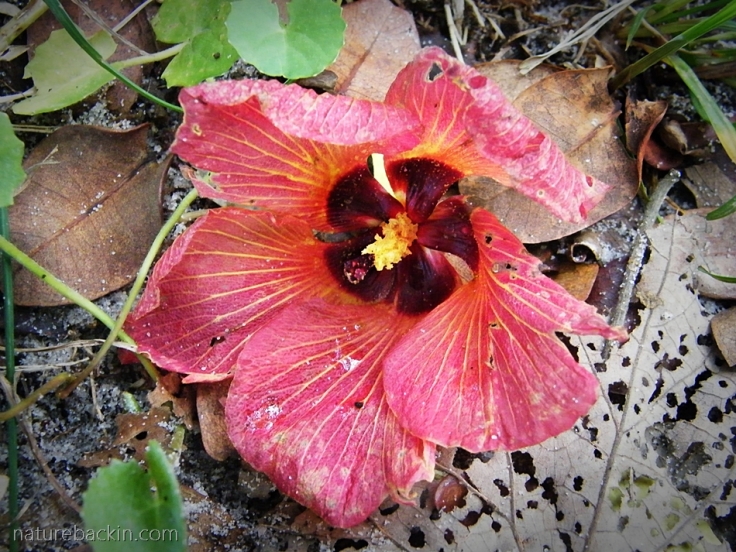
Also at Kosi Bay, a mature flower of the Lagoon Hibiscus, fallen to the ground

Sources: Achigan-Dako, E.G., 2011. Hibiscus tiliaceus L. [Internet] Record from PROTA4U. Brink, M. & Achigan-Dako, E.G. (Editors). PROTA (Plant Resources of Tropical Africa / Ressources végétales de l’Afrique tropicale), Wageningen, Netherlands. https://uses.plantnet-project.org/en/Hibiscus_tiliaceus_(PROTA); Boon, Richard. 2010 (2nd ed.). Pooley’s Trees of Eastern South Africa. Durban: Flora & Fauna; Pooley, Elsa. 1998. A Field Guide to Wild Flowers of KwaZulu-Natal and the Eastern Region. Durban: Natal Flora Publications Trust; Van Wyk, Ben-Erik and Gericke, Nigel. 2007. People’s Plants: A Guide to Useful Plants of Southern Africa. Pretoria: Briza; Viljoen, Cherise. 2010. Hibiscus pedunculatus. PlantZAfrica. South African National Biodiversity Institute (SANBI). http://pza.sanbi.org/hibiscus-pedunculatus
Posted by Carol







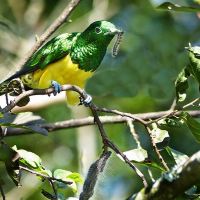
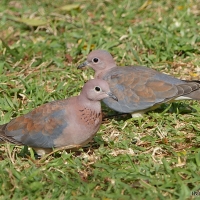
April 4, 2021 at 2:10 pm
This was a lovely post, Carol. How wonderful to live where wild hibiscus exists. My only experiences with hibiscus are in Hawaii, the big showy flowers you mention. So it was very interesting to read your engaging narrative and see the photos of other species. I never knew they were part of the mallow family, nor that baobab and cotton were part of it too. Interesting about the rope quality of the bark. Thank you.
LikeLiked by 1 person
April 5, 2021 at 2:52 pm
Thanks very much Jet. Strangely, the varieties that Hawaii has made famous have been more popular in gardens here than our own indigenous varieties, even though they are so lovely. They are part of a large and interesting family!
LikeLiked by 1 person
June 22, 2019 at 10:43 am
Fascinating as ever, and very timely. We inherited a pair of hibiscus plants in the border. Everyone reacts with awe when told what they are: hibiscus have such an exotic reputation here of course. In truth, I am not fond of them. The flowers are a vivid blue – almost turquoise – and seem out of place and artifical to me. They are currently bursting into leaf, and flowers will follow later in the summer. I shall look at them differently having read your article and try to feel more kindly towards them 🙂
LikeLiked by 1 person
June 23, 2019 at 6:58 pm
It is strange how the hibiscus is freighted with such an aura of exotic allure. I agree that some of the fancy cultivars can have such peculiar vividness that they seem unnatural. I do prefer the more natural and simple versions.
LikeLiked by 1 person
June 19, 2019 at 6:49 am
Fascinating. What a beautiful and surprising flower. I cannot think of any British species that take the ‘flowers last one day but flowering season goes on’ approach.
LikeLiked by 1 person
June 23, 2019 at 6:17 pm
It is a surprising form of abundance the more one thinks about it!
LikeLike
June 16, 2019 at 6:21 am
The flamboyant Chinese hibiscus is dominant here, but for whatever reason, I don’t see a lot of insect activity around them. Don’t know whether that’s just something happening locally or a more widespread trend. I do like your forest hibiscus for both its color and simplicity. South Africa is home to so many varieties of plants, you must be spoilt for choice.
LikeLiked by 1 person
June 16, 2019 at 8:57 pm
I wonder if there is a growing awareness of some of the native hibiscus species in Hawaii? It would be interesting to know why there are not a lot of insects around the exotic hibiscus. Yes our little forest hibiscus is lovely, and in our garden at least it seems very attractive to a variety of insects. We certainly are spoilt for choice in South Africa with an incredible number and diversity of plants,
LikeLiked by 1 person
June 17, 2019 at 4:05 am
I think there’s a growing awareness of native species in general here. Considerable efforts are being made to protect and nurture them, plants and birds especially. It’s encouraging to see.
LikeLiked by 1 person
June 17, 2019 at 5:07 am
Yes that is good to know. Thanks.
LikeLiked by 1 person
June 14, 2019 at 1:24 pm
Beautiful flowers, beautifully written 💕🌺
LikeLiked by 1 person
June 16, 2019 at 5:08 am
Thanks for the lovely comment Debs xx ❤
LikeLike
June 14, 2019 at 4:45 am
I have enjoyed your lovely photographs: the Forest Pink Hibiscus in my garden was grown from seed purchased at Kirstenbosch. It hasn’t self-seeded as much as you describe, although this may be the result of the area becoming too shady. I agree with your identification of the Hibiscus calyphyllus. It is fairly prolific in our area.
LikeLiked by 1 person
June 16, 2019 at 5:06 am
Thank you Anne. It is interesting that you first grew this plant from seed. Have you tried gathering seed just before it disperses and scattering or planting it in more suitable places?
Thanks very much for confirming the ID of the Hibiscus calyphyllus. I must visit the local indigenous nursery to see if I can find one for the garden. They are not that noticeable growing wild in our region but a I will keep more of an eye out for them.
LikeLike
June 14, 2019 at 1:32 am
I must admit that I was flabbergasted when I first learned many years ago that we have indigenous hibiscus in South Africa, never mind that they are as beautiful as the exotic version that was growing in my parent’s garden! Up until then, on the odd occasion that I noticed one I assumed that it was an exotic invader!
This post of yours so clearly and interestingly illustrate again why South Africa is the natural home of so many of the world’s most popular garden plants – we have such a diversity of delicate and beautiful blooms!
LikeLiked by 1 person
June 16, 2019 at 4:59 am
I grew up with similar experiences regarding the hibiscus. For a long time I thought the South Coast was named for the exotic garden ornamental especially as it was regularly featured on local advertising billboards for beach holidays rather than the indigenous Lagoon Hibiscus.
We are so fortunate to have such a diversity of plants in South Africa. I am thinking I should try to get a yellow flowering species for the garden.
LikeLiked by 1 person
July 2, 2019 at 2:08 am
That’s a great excuse to go walking through the nursery at Skukuza in the Kruger Park next time you visit there, Carol – whenever we’re in that part of the Park we try to spend a bit of time there as it is always such a lovely experience!
LikeLiked by 1 person
July 4, 2019 at 7:33 pm
Thank you – it sounds great.
LikeLiked by 1 person
June 14, 2019 at 12:18 am
I have to say I like your Forest Pink Hibiscus far better than the more flamboyant, more familiar varieties. I tend to favor the more delicate colors for the most part. You captured the different phases of this lovely plant so well. What a treasure to have in your garden. It’s a pleasure to visit.
LikeLiked by 1 person
June 16, 2019 at 4:50 am
I also like the relative simplicity of the forest pink. Some of the artificial varieties can be extremely flamboyant! Thanks for visiting our garden 😊. I also like seeing such plants in the wild in their natural context where they look more integrated than when planted in a garden somehow.
LikeLike
June 13, 2019 at 10:39 pm
I also didn’t know there were so many varieties of hibiscus, or the fact that they were in the same family as plants such as baobab. I can’t grow tropical hibiscus here because of frost, but Hibiscus syriacus does very well. I can see why you described the Forest Pink ‘generous’.
LikeLiked by 1 person
June 16, 2019 at 4:43 am
I also found the baobab connection surprising. The Hibiscus syriacus looks lovely and seems to have similarities to our Forest Pink judging from photos.
LikeLiked by 1 person
June 13, 2019 at 9:06 pm
What attractive plants. I had no idea there were so many varieties.
LikeLiked by 1 person
June 16, 2019 at 4:39 am
Yes I was surprised at the numbers too.
LikeLike
June 13, 2019 at 8:58 pm
All are beautiful, Carol, but I especially like the Forest Pink Hibiscus.
LikeLiked by 1 person
June 16, 2019 at 4:36 am
Thank you Sandy. Yes it does have a more delicate charm.
LikeLiked by 1 person